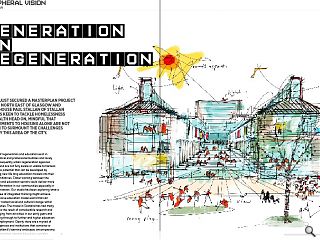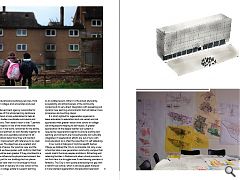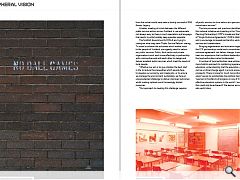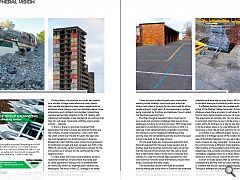Paul Stallan: Peripheral Vision
15 Jul 2015
Having just secured a masterplan project for the north east of glasgow and easterhouse paul stallan of stallan brand is keen to tackle homelessness and health head on, mindful that improvements to housing alone are not enough to surmount the challenges faced by this area of the city.
The worlds of regeneration and education exist in different political and professional bubbles and rarely overlap. Consequently urban regeneration agencies across Scotland are not fully aware or unable to harness the enormous potential that can be developed by incorporating new life long education models into their community initiatives. Closer working between the regeneration and education sectors could deliver more radical transformation in our communities especially in areas of deprivation. Our studio has been exploring what a greater degree of integrated thinking might achieve.A progressive education model exists that can deliver deep-rooted social and cultural change within our communities. The model in Scotland has had many authors and is the result of considerable research and practice ranging from activities in our early years and infant learning through to further and higher education leading to employment. Clearly there are a myriad of education agencies and institutions that combine to complete Scotland’s learning landscape; encompassing our schools provision, teacher education, complex learning needs, educational psychology services, third sector inputs, our colleges and universities and even prison education.
The Scottish Government agency responsible for having an overview of this whole learning landscape is Education Scotland, a body established to help all of these different bodies coordinate curriculums and learner progressions. Their stated vision is that: “Learners in Scotland will progress in one of the most effective education systems in the world, renowned for the ability of national and local partners to work flexibly together to achieve high-quality and equitable outcomes for all”.
Education Scotland detail how they will maintain quality and drive improvement with reference to six clear strategic objectives. The objectives are excellent and make a great deal of sense. Our practice view and the view of many that we have spoken with confirms that their achievements could be even greater if they prioritised to a greater extent the influence the physical environment has on learning - not just for our buildings but our places.
It is our studios view that it is not enough to focus on the refurbishment or delivery of a new school or the rationalisation of a college estate to support learning as an isolated event, rather it is the actual physicality, accessibility and attractiveness of the community context and its very direct integration with appealing and dynamic new learning environments that will deliver more prosperous and exciting places.
It is short sighted for regeneration agencies to leave education to education (and vice versa) and not appreciate what greater value a new school or college can bring beyond helping to sell houses. A greater appreciation of the deeper learner eco-system is required by regeneration agents to ensure exciting new learning environments are more physically and culturally integrated. If regeneration efforts are out of sync with local education as is often the case then it’s self-defeating.
In our work at Glasgow’s Commonwealth Games Village we lobbied the City to incorporate not only a new school but also a new generation community campus that would match the local peoples ambitions. Attracting and retaining families in Dalmarnock when school provision is not first class is a struggle even if new housing provision is fantastic. The City is now quickly addressing this gap with a retrofit new school, which is obviously great however a more blended regeneration and education approach from the outset would have been a doubly successful 2014 Games Legacy.
A better meeting of minds between the different public service sectors across Scotland is, we appreciate, not always easy, as there is much specialism and language that seems to unfortunately keep agendas separate.
The Scottish Government & COSLA are trying to champion what they term ‘Public Service Reform’ stating: “In order to achieve the outcomes which matter most to the people of Scotland, we urgently need to reform our public services. Public, third sector and private organisations must work more effectively in partnership with communities and with each other to design and deliver excellent public services which meet the needs of local people.
“Whether our aim is to give children the best start in life, to reduce the inequalities which people face, to develop our economy and create jobs, or to ensure we manage the environment sustainably, we face an unprecedented challenge to deliver improved outcomes whilst making optimal use of increasingly limited resources.
“Our approach to meeting this challenge requires all public services to drive reform at a pace across mainstream services”.
The two processes and practices identified to help this national initiative are investing in the ‘Community Planning Partnerships’ (CPP’s) model and the formulating of ‘Single Outcome Agreements’ (SOA’s). Both platforms aim to encourage increased partnership working between services and stakeholders.
Bringing regeneration and education together using the CCP partnerships model and a commitment to a single outcome agreement can deliver change. In addition it has been our experience that confident leadership from within the local authorities is also fundamental.
A number of local authorities have embraced a more holistic approach to combining regeneration with education, understanding that the education continuum can be a critical change agent in a local economy’s prospects. There is scope for much more initiative in this area if we are to substantiate the political claims that ‘Learners in Scotland will progress in one of the most effective education systems in the world’. I would claim this could only be achieved if the learner environments are also world class.
Putting theory into practice our studio has posited on a number of large-scale urban and rural projects that new life long learning ideas when coupled with an ambitious place making vision can ultimately deliver more enterprising and confident communities. Interestingly we have learned that urbanists in the U.S. dealing with collapsing metropolitan areas like Detroit are claiming that their city will never come back until they improve their schools … radically.
In the U.S. there is a growing movement that appreciates that after housing, educational facilities are the linchpins of urban renaissance. Critics claim that the urban school over the last 40 years has been one the most neglected civic building types in America. Researchers claim that the urban school must go beyond its traditional concept and even concepts put forth in the 1980s of community center to embrace a concept for the 21st century as a ‘campus for the communal life of the neighbourhood’.
In urban areas with acute social problems we have researched instances where schools are being seen as ‘urban generators’ aiding in the re-establishment of community within our blighted post-industrial city landscapes. The focus of this U.S. strategy is to create a ‘learning campus’ where the school has a critical civic function but also a place making role.
Closer to home Scotland equally has communities needing similar strategic input some post industrial, others rural where a ‘campus for the communal life of the neighbourhood’ might work. A local example is a project being promoted by Dumfries and Galloway Council called the ‘Dumfries Learning Town’.
Dumfries though a beautiful historic town has its own social and economic challenges that require to be addressed including its schools provision. With three tired secondary schools and six primary schools in what is a relatively small settlement early proposals by Dumfries and Galloway Council imagined mothballing all the existing sites and consolidating activity around one super school to be built on the edge of town.
On one level there was a persuasive education and financial argument for the super scale scenario but at another level the Dumfries community were concerned that the removal of the schools from the centre would have a detrimental impact on the towns character and viability. It is clear the schools help populate this rural town and their removal would dramatically impact small shops, businesses and daily rituals.
The distributed schools contribute an essential activity making the actual town of Dumfries the extended school campus. Losing these schools would decimate the local economy and definitely not reverse the current phenomena of boarded up shop fronts. We think that this is a brilliant example of joined up public sector thinking.
A different decision that has parallels with Dumfries is that of the Madras College Secondary School in St. Andrews where there are plans to withdraw from their historic town centre location in favour of a green belt site. The arguments are complex and I do not know enough to comment other than to say it will be a loss not having pupils within St. Andrews on a day-to-day basis. I do think it will be a lesser place in my view although St. Andrews does have a more robust local economy to compensate.
In contrast a very different project we are considering presently is a strategic review of the Greater Easterhouse area of North East Glasgow. It is very early days in this study however as a key ‘generator’ we are exploring with the community how a different, more radical learning offer building on the excellent work all the education stakeholders are currently providing can be delivered; i.e. a completely integrated vision for a future Easterhouse that achieves a more virtuous circle of life and new optimism.
In short or studio believe that by combining contemporary learning with our place making ambitions in Scotland that we can radically improve people’s lives. Through a different kind of partnership working we believe we can deliver a ‘1 + 1 = 3 opportunity’ that would put the essential ‘generation’ into re-generation.
|
|
Read next: Planning: Turf War
Read previous: Linwood: Park Life
Back to July 2015
Browse Features Archive
Search
News
For more news from the industry visit our News section.
Features & Reports
For more information from the industry visit our Features & Reports section.






